

In the philosophical literature, perhaps the most common taxonomy of consciousness is into "access" and "phenomenal" variants.


Neuroscience hypothesizes that consciousness is generated by the interoperation of various parts of the brain, called the neural correlates of consciousness or NCC, though there are challenges to that perspective. The aim of the theory of artificial consciousness is to "Define that which would have to be synthesized were consciousness to be found in an engineered artifact" ( Aleksander 1995). ( June 2020) ( Learn how and when to remove this template message)Īrtificial consciousness ( AC), also known as machine consciousness ( MC) or synthetic consciousness ( Gamez 2008 Reggia 2013), is a field related to artificial intelligence and cognitive robotics. Parenthetical referencing has been deprecated convert to shortened footnotes. Please improve this article by correcting them. This article includes inline citations, but they are not properly formatted.


 0 kommentar(er)
0 kommentar(er)
